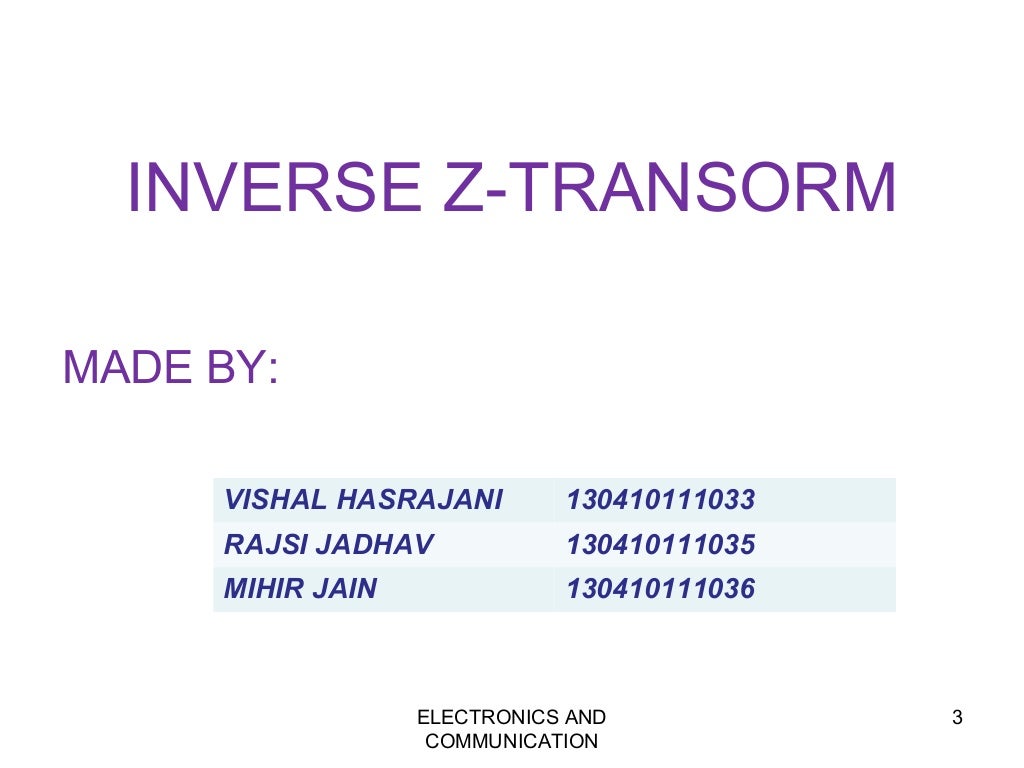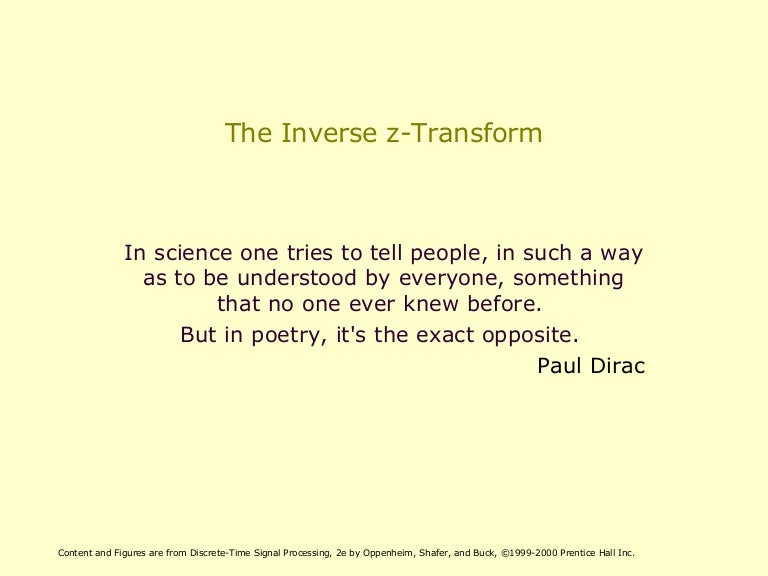If we want to analyze a system, which is already represented in frequency domain, as discrete time signal then we go for Inverse Z-transformation. Mathematically, it can be represented as; x (n) = Z − 1 X (Z) where x n is the signal in time domain and X Z is the signal in frequency domain. AND THE INVERSE Z-TRANSFORM Objectives: Modulation, Summation, Convolution Initial Value and Final Value Theorems Inverse z-Transform by Long Division Inverse z-Transform by Partial Fractions Difference Equations Resources: MIT 6.003: Lecture 23 Wiki: Inverse Z-Transform CNX: Inverse Z-Transform Arslan: The Inverse Z-Transform CNX: Properties. The basic idea now known as the Z-transform was known to Laplace, and it was re-introduced in 1947 by W. Hurewicz and others as a way to treat sampled-data control systems used with radar. It gives a tractable way to solve linear, constant-coefficient difference equations.It was later dubbed 'the z-transform' by Ragazzini and Zadeh in the sampled-data control group at Columbia. The inverse z transform The inverse z-transform can be found by one of the following ways Inspection method Partial fraction expansion Power series expansion Each will be explained briefly next 1 2. Inverse z transform by inspection method The inspection method is based on the z transform pair table.
- Digital Signal Processing Tutorial
- Operations on Signals
- Basic System Properties
- Z-Transform
- Discrete Fourier Transform
- Fast Fourier Transform

- Digital Signal Processing Resources
- Selected Reading
If we want to analyze a system, which is already represented in frequency domain, as discrete time signal then we go for Inverse Z-transformation.
Mathematically, it can be represented as;
 $$x(n) = Z^{-1}X(Z)$$
$$x(n) = Z^{-1}X(Z)$$where x(n) is the signal in time domain and X(Z) is the signal in frequency domain.
If we want to represent the above equation in integral format then we can write it as
$$x(n) = (frac{1}{2Pi j})oint X(Z)Z^{-1}dz$$Here, the integral is over a closed path C. This path is within the ROC of the x(z) and it does contain the origin.
Methods to Find Inverse Z-Transform
When the analysis is needed in discrete format, we convert the frequency domain signal back into discrete format through inverse Z-transformation. We follow the following four ways to determine the inverse Z-transformation.
- Long Division Method
- Partial Fraction expansion method
- Residue or Contour integral method
Long Division Method
In this method, the Z-transform of the signal x (z) can be represented as the ratio of polynomial as shown below;
$$x(z)=N(Z)/D(Z)$$Now, if we go on dividing the numerator by denominator, then we will get a series as shown below
$$X(z) = x(0)+x(1)Z^{-1}+x(2)Z^{-2}+...quad...quad...$$The above sequence represents the series of inverse Z-transform of the given signal (for n≥0) and the above system is causal.
However for n<0 the series can be written as;
$$x(z) = x(-1)Z^1+x(-2)Z^2+x(-3)Z^3+...quad...quad...$$Partial Fraction Expansion Method
Here also the signal is expressed first in N (z)/D (z) form.
If it is a rational fraction it will be represented as follows;
$x(z) = b_0+b_1Z^{-1}+b_2Z^{-2}+...quad...quad...+b_mZ^{-m})/(a_0+a_1Z^{-1}+a_2Z^{-2}+...quad...quad...+a_nZ^{-N})$
The above one is improper when m<n and an≠0
If the ratio is not proper (i.e. Improper), then we have to convert it to the proper form to solve it.
Residue or Contour Integral Method
In this method, we obtain inverse Z-transform x(n) by summing residues of $[x(z)Z^{n-1}]$ at all poles. Mathematically, this may be expressed as
$$x(n) = displaystylesumlimits_{allquad polesquad X(z)}residuesquad of[x(z)Z^{n-1}]$$Inverse Z Transform Ppt Example
Here, the residue for any pole of order m at $z = beta$ is
Inverse Z Transform Pdf
$$Residues = frac{1}{(m-1)!}lim_{Z rightarrow beta}lbrace frac{d^{m-1}}{dZ^{m-1}}lbrace (z-beta)^mX(z)Z^{n-1}rbrace$$